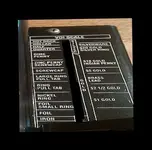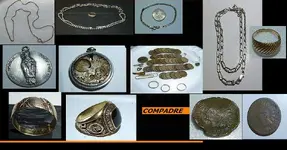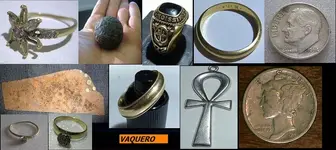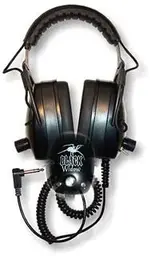So how do u find the "good stuff"? Do Tesoro owners dig everything or is there a way to tell a good target from junk with these machines that i am missing? I spent 2 hours the other day at a local park that has provided me with alot of coins and several silver rings. I decided to only try for gold rings and jewelry, so i dug every good signal with vdi's of 48-70 and also digging some clad coins as i went.....well i ended up with a pouch full of pull tabs and about 2 dollars in clad but i did get 5 nichols witch was a rare thing for me. Anyway, how would you hunt this park with a Tejon if you were looking for coins and jewelry? This park is covered in pull tabs, peices of foil and can slaw....
I have a Compadre and a Vaq and hunt trashy parks and other sites all the time.
I also use an F2 with a screen and I got very good with that, but I also got pretty good using those Tesoros with no screen and I believe I am now to the point that I can tell trash from good target about the same with both types of units.
They say Tesoros are beep and dig but this is not true at all.
I consider them beep...figure it out ...then dig detectors, and there are plenty of tips and techniques you can use to quickly tell what you are swinging over more often then not.
Nothing is 100%, even the best machines are just making a guess and nobody knows what they are scanning till they dig it, but learning the language of your chosen detector can definitely increase finds and help you dig less trash.
Here are 2 posts I have on another forum about hunting with Tesoros.
One was in answer to a newbie with the same question about figuring out targets, the second is how I figured out how to use my no screen machines the best way possible...for me.
Hopefully, these will give you an insight about how we use these, why they are so much fun to use when you get good with them and guess right before you dig, and why owners just seem to love them so much.
Below are pics with just some of the "good stuff" I have found with my Tesoros.
----------------------------------------- ----------------------------------------- --------------------------------------
Reply to a newbie just starting out with a Compadre...
Look at the picture below.
Here is where metals will show up on your dial.
Study and remember their locations.
The way you figure out what you are digging before you dig it, which is never 100% by the way, is to "thumb" that disc knob and figure out where the metals in the range you see in the picture go away or "disc out".
*Tip*....It is more accurate to turn the knob way up and then turn it down slowly as you are swinging over the target and stop at the area where you hear a tone come in, than to turn it up until it fades out.
Now you have done this and lets say it was silent till you got to the zinc mark.
Now you have a clue, and this hobby is all about taking all your clues and putting them together to make an educated guess.
From studying the picture, you remember that this zinc area should sound off if you have a zinc penny or other zinc item, an Indian head penny, a screw-cap or gold.
Might be some other things like can slaw, but it could be one of the first four, too.
Maybe you want to switch closer to all metal, now, and run your coil around the target area and try to size the target.
Where does the tone sound loudest and then fade out?
Hit it from a different angle and try to get a picture in your mind on how big it is...coin size, maybe a little bigger?
In all metal or turning it back below zinc on the disc knob, how loud does it sound when you scan it?
Really loud, maybe medium loud or softer?
This gives you a clue on the depth.
Another depth trick is lift the coil and swing over it.
Do you lose it at 3 inches above the ground, 4-5?
If you know your limit of your detector, and subtract the height of your coil above the target where it goes silent, this can give you approximate depth.
Now you decide to whip your coil over the target real fast and see if the tones stay solid from all angles or breaks up.
If it breaks up it could be trash, if not, still might be a good target.
All of these techniques are aimed to give you clues, and those clues will lead you to an educated guess and that will lead you to digging a hole...or not.
As you put in your time, you also start to hear slight differences in that tone.
A zinc penny might sound very solid and full and the same all the way through, but a screw-cap might not sound so full.
Maybe you noticed after locating and scanning hundreds of these that a screw-cap doesn't stay full, but maybe breaks a little right at the end.
It gets a little fuzzy.
You never could tell the difference at the beginning, but now, after much practice, you can hear that difference, and so you have another good clue as to what you might have sitting in the ground below you.
Solid tone, rings true, no breaking of the signal, small like a coin, really loud tone, can raise the coil pretty high before it fades out...I think this is a zinc penny that is about 1 inch down...then you dig it...and it is.
Or maybe not, like I said, not 100% in this hobby...ever...but you cut your odds down some on digging trash, and you made a good guess.
It's a process.
As you progress, your guesses get better.
The universe must be laughing at us that do this hobby because it made so many bad things ring up in the same areas as so many good things.
Aluminum hangs out where the high tone coins do.
Nickels and gold live in the same neighborhood as pull tabs...as a matter of fact, gold seems to live in almost all the neighborhoods.
Nobody is perfect, we all dig lots of trash, but the better you get the less trash you dig and the more treasure you find.
Study the picture, know your metals and where they line up in relation to your disc knob.
Then practice, practice practice.
Really listen and try to remember that tone you hear before you dig a target, then remember what target you dug after that specific tone.
It takes time for your instincts to kick in and this stuff becomes second nature, but it will eventually happen.
Once you dig enough holes.
That's how I do it.
----------------------------------------- ---------------------------------
How I hunt using my Compadre and Vaquero in trash...
This is what I have learned about dealing with trash using Tesoro detectors.
I am usually a dig it all solid signal hunter but late last year I got real tired so for about a month I stopped doing so much of that and at the end of some long hunts do it still, and I have worked very hard at trying to figure out trash even better and more accurately so those "what if" feelings don't drive me insane when I am in that kind of mood.
I think I might be a little crazy compared to others because so many try to avoid digging tons of trash and I seem to be the opposite where I love digging it and the trashier the site the better I like it.
Well, maybe not like so much as long ago I decided this is the best way to hunt...for me, and I do this for the exercise as much as finding treasure so there is that reason, too,
I suspect the real reason I got to this point is among all the trash signals I have dug I have also had some major surprises along the way...very huge and delightful surprises... and I just can't seem to wrap my head around the idea of ever missing anything good let alone great...so I dig and I am fine with it.
For those times when I just don't feel like digging every blasted thing I come across I have read about and use some well known tips others have posted like whipping the coil over a trash target quickly and noticing if it breaks up, or lifting the coil as I swing over a target and listening to see if it breaks up at the edge of the scanning field or just fades out, and these techniques work.
I have also done a lot of experimentation discovered something else.
On every target I come across, and I mean every one, I got in the habit long ago of NOT just turning that disc knob up till the signal fades out to see what area the knob is pointing to figure out target types like all the manuals say, but I always turn all the way past the area till the target fades out completely and then slowly turning down the knob to the point where the target comes in .
Except high tone targets like quarters that don't disc out, of course.
After several zillion targets acquired and dug I am convinced this is a much more accurate way to figure out just about every target.
I get so much more information out of not only seeing where that disc knob ends up when the signal is solid and full, but more importantly I get even more info when I hear precisely HOW that
target comes in.
I noticed that and most good targets like coins, definitely on others like rings that are full and not broken, and surprisingly on most chains too, when I turn down that knob most good targets will just "come in"...solid and full...there is very little crackling or fuzzyness in that signal most of the time, not even one or two clicks.
Trash on the other hand usually does have much more crackling and clicks in that signal before it firms up and I assume this is because most detectors are designed to home in on solid round objects like coins and not irregular shapes like trash or objects with holes like tabs.
Now this is not true 100% of the time because the universe and life just doesn't work this way for us in this hobby.
There are some trash targets that do act like good coin targets and will come in full and solid and with no clicks.
Some beaver tail tabs with that tail folded over, foil that is thick like a coin, compressed and formed into a round coin shape, some small coin shaped pieces of can slaw and even a few sta-tabs do fool me me from time to time because there is virtually no difference between some of these and a real coin signal.
If those kind of targets are laying completely horizontal and flat in the ground this can compound this problem, but luckily most trash is not horizontal but turned slightly on edge to almost vertical, in my experience, and react accordingly with much crackling and clicks.
Conversely, sometimes good targets like coins do act weird and have some fuzzyness and at least a few clicks before solidifying, too.
I noticed this happen on a few zinc pennies and nickels can be totally weird, sometimes.
Yesterday I was using my Compadre and dug a nickel that was a little iffy and didn't even disc out till close to the tab section, and another nickel that came in at the correct area on the disk knob but still acted very crackily just like trash.
Even though I was a little tired at this point and was not digging all trash I still dug both of these signals because I heard something in each signal that triggered my digging impulse...a slight solid tone that rang true even though they were very short nowhere near the very solid type signals that most good targets I dig emit.
Exactly why I dug those is hard to explain but I just chalk that up to an ability I have acquired over the hundreds and hundreds of hours swinging my Tesoros...something most Tesoro owners can attest to once they accumulate
enough time and experience in listening and learning the Tesoro language and quality of the tones.
The good thing about all this is that even though I do this thumbing knob thing on all targets to figure them out I also dig most targets too, and I can proudly say I have gotten good enough to correctly determine trash from treasure about 90% of the time.
On hunts where I don't dig every signal I still do check myself and dig many of the trashy ones throughout every hunt just to make sure...again those what if feelings will mess with my head and destroy me if I don't...and this is no matter how tired I am.
The best thing is my greatest targets I have found like gold rings, silver coins and silver bracelets and chains, this technique worked 100% on those type of targets every time.
Don't think this thumbing, listening figuring out thing takes a whole lot of time either.
I have had so much time in doing this and so much practice I have gotten extremely fast at it and usually beat out any and every hunting partner in shear volume of targets dug even though I take a few seconds to do this on every one, and still seem to hit those correct guesses somewhere around that 90% number most of the time.
I am not saying I never leave any good target in the ground doing it this way, after all if I never dug a trash sounding but still good target how would I ever know, but I can tell you that I have had a few hunts where I was avoiding digging as much trash as I could and still walked away from 2 in particular with a pretty empty trash pouch but a couple of really great treasures.
One was a nice silver necklace that came in as foil, and another which was a gold ring that also came in as a higher foil signal but below nickel.
Trash targets both in a site filled with other trash targets that came in at exactly the same positions as many trash signals at these sites and yet still sounded good, and more importantly met my criteria of coming in solid with very few if, any, clicks at all.
I read all posts on several forums about techniques using the Tesoro detectors and try to remember and use them when I need to, but I have not read many that talk exactly about this sort of technique of turning past the fade out point and back, or if they do at the very least using it as much as I do.
On my Compadre I know this works tremendously, on my Vaquero it seems to work just about as well, especially when using a concentric coil over my DD which has a slightly sharper disc ability.







